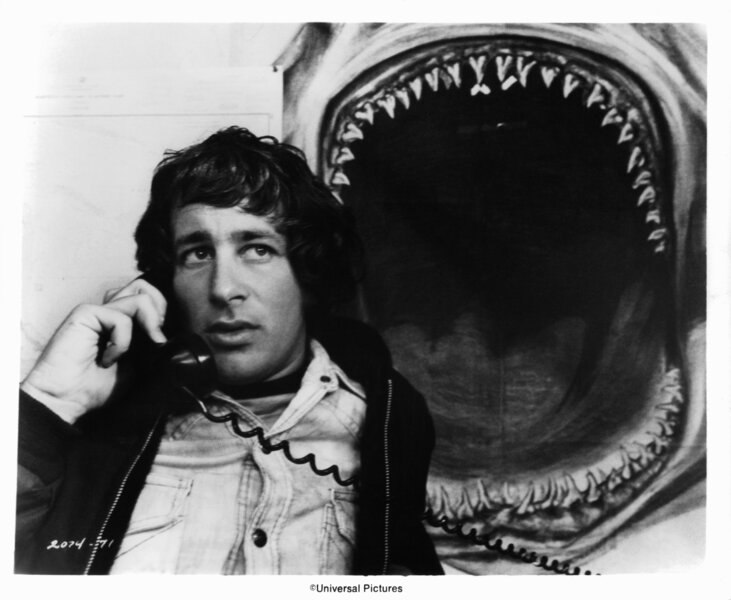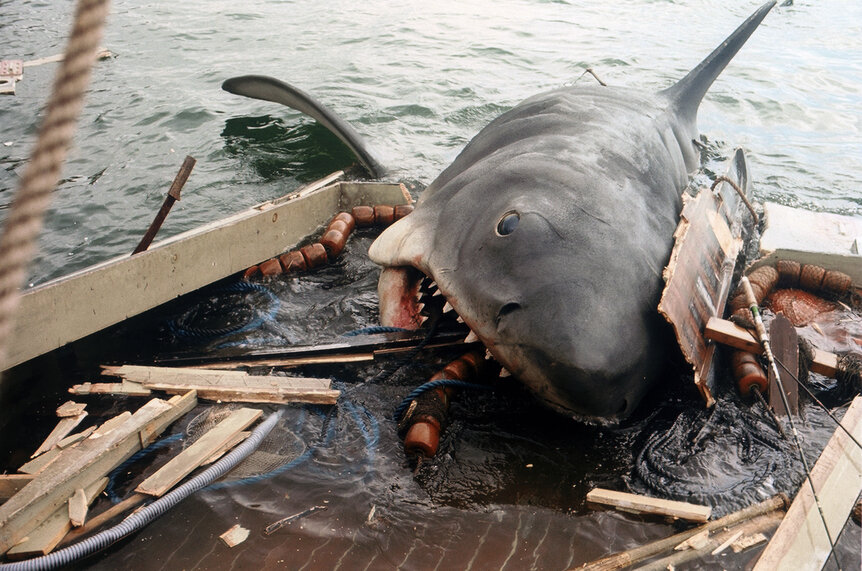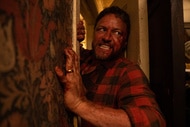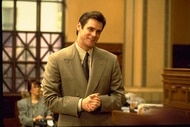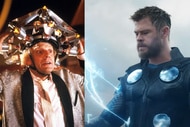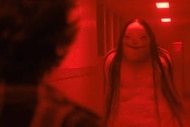Create a free profile to get unlimited access to exclusive videos, sweepstakes, and more!
Jaws at 45: Joe Alves designed Bruce the shark — and kept Jaws from sinking

It's been 45 years since Jaws first ruined beach-side summertime fun for people everywhere. But none of that — "Tell 'em I'm going fishing," "You're gonna need a bigger boat," "Smile, you son of a bitch!" — could have happened without production designer Joe Alves, who designed not just the production, but the film's biggest and most difficult star: Bruce, the mechanical shark named after director Steven Spielberg's lawyer.
Alves was in it from the beginning, even before the wunderkind director hopped aboard. The art department vet (who'd worked with Spielberg before as the art director on his first theatrical feature, The Sugarland Express) was asked by producer David Brown to create some illustrations of Peter Benchley's soon-to-be bestseller, Jaws. "He just asked if I could go through the galleys and make a lot of illustrations to sell the idea to the studio of doing a shark movie. And Steven wasn't aboard yet, so that was probably August, September of '73," Alves told SYFY WIRE while promoting the film's new 45th-anniversary limited-edition 4K Ultra HD release, available tomorrow, June 2. "And that's how that started."
Alves showed Spielberg the illustrations, and bold ideas were immediately bandied about.
"[Spielberg] said, 'God, if we do this, we should do a big full-sized shark, 25 feet, in the real ocean. Not in the backlot tank or something,'" Alves says.
Sounds simple enough, right? But both tasks — the shark and the ocean — would ultimately become legendary hardships, as Jaws' production became so epically difficult it has actually inspired musicals. So why put themselves through such labors?
"We had looked at some other movies that used big marlins and stuff like that, and they looked phony, you know, they didn't look real. A tank with a painted background doesn't look like the real ocean," Alves says. "Nobody had really done it. Disney made, I think, orcas and stuff, but they were shot in tanks. So when we decided if we're going to do this, this is the way we want to do it, the studio effects department said they couldn't do it, it'd take a year and a half to make the thing, it's never been done."
So Universal's head of production told Joe to "take it off the lot" to build the shark (well, ultimately three sharks). Alves assembled a crack team and got to work. But time wasn't on their side. "That was probably November '73, the book came out in February '74, and the studio said, 'We're going to start shooting in two months.' Which is why we had all the problems with the shark, because we didn't have the time to test and develop it."
What could go wrong?
"You don't know you're going to have a problem, because it's never been done before," Alves says.
They'd find out pretty quickly, though.
"We were into it like four, five months at the most, and we're testing it and it wiggles. And we built it in Sunland here in the Valley, and we shipped the three sharks — there are three sharks, left to right, right to left that was towed, and then one on a big crane — and so we got to Martha's Vineyard and we started testing it. And the first problem we found was salt water doesn't like electrical stuff," Alves explains.
"As soon as we got in the water and we start moving it around, all the old electronic stuff started getting invaded by the salt water. So we have to pull that out and redo that and then the various mechanics," he continues. "I have a book that came out this year called Joe Alves: Designing Jaws, it's on Amazon, and there are shots you could see the opening side of the shark and all the various rams and all the mechanics and how difficult it was to make this thing, because it wiggles, it swings, it comes up and bites... it was like nothing that's ever been done before in the real ocean."
But the show had to go on (and on, and on, and on ...).
"We just kept working on it, and Steven shot everything he could without the shark, all the walk and talk. And then the shark started to work," Alves recalls.
While having to work without Bruce certainly forced Spielberg and company to get creative, they eventually got exactly what they needed.
"I had storyboarded, which is in the book, all the shots with the shark we got. So we didn't not get shark shots. People say, 'Oh you didn't use the shark much because it wasn't working.' Well, that's not true," Alves says. "Eventually, as I say, we got every shot I had storyboarded. So it worked out fine, it just took a while, that's all."
What're an extra 104 days of production, really?
"The crew was exhausted," Alves recalls. But the shark wasn't the only problem; there was also that pesky ocean — which was pesky for all the elemental reasons you'd expect, but also another under-considered issue.
By December of 1973, Alves' location scouting had homed in on Martha's Vineyard, with its 25-foot-deep bay and a small enough tide that it was "perfect for the shark." The location also captured the isolation of the open ocean that Spielberg wanted.
Granted, December in Martha's Vineyard ain't exactly prime time. By the time summer rolled around, the production was dealing with a very different locale.
"Come June, July, August ... suddenly, there's all these boats from Hyannis and all over sailing around, and Steven wanted them totally isolated," Alves says. "So not only did we have a water problem or a shark problem, we had boat problems. And so we had to wait till they moved out of the way. Some people cooperated; some people didn't. So a lot of that delay in the shooting was waiting to get a clear shot with no boats on the horizon."
Eventually, those clear shots included Bruce, who, despite his reputation, really was an incredible achievement. But just the same, discretion is the better part of horror.
"You could overuse a shark, and some of these other shark [movies], they just overuse it. And I think Steven was very smart in being very selective," Alves says. "We have a shot, it was the first shot where the shark works, where it's a high shot and the shark goes by the boat. It just swims gently, and you say, 'Oh my God, it's almost as big as the boat.' So you want those shots, but you don't want to keep repeating them."
Alves knew early on they had caught the shots they'd gone fishing for.
"That first shot when the boat went by, I was so pleased with that. And then when it comes up and Scheider says, 'We're gonna need a bigger boat,'" he explains. "And I think one of the best shots was coming into the cabin, you know, and then he puts the tank in his mouth and he goes away. I thought that worked really quite well."
45 years' worth of satisfied viewers would likely agree.
We all know what happened to Spielberg. But Alves himself also went on to a long and storied career in production design, including working on the wunderkind's next masterpiece, Close Encounters of the Third Kind. He also worked on two more Jaws films: as associate producer, second unit director, and production designer on Jaws 2, and as the director on Jaws 3D, which was apparently enough directing for him.
"It was terrible," Alves says of the experience. "I came up with the idea of making it 3D. And so then I got the directing job, but then I realized they didn't have any new cameras. They were all old. So we had to make cameras, and we got to get the convergence right, and I had this television producer [Alan Landsburg] that was, 'Got to do it quick, quick, quick.' So it was extremely difficult in the technology, you know, just shooting it, because the convergence wouldn't be right, and we'd have to check it. And that was very, very difficult. And then, I got to say this: I didn't have final cut. So I cut the movie to a certain length, as with the other two, and then he cut about 20 minutes out of the personal relationships, which is okay. But you know, still, it was very, very successful, made a lot of money. So ..."
Though not available in 3D just yet, the 45th Anniversary Limited Edition of the one and only Jaws arrives June 2 with both Blu-ray and 4K Ultra HD viewing options and includes three-plus hours of bonus features and a 44-page book filled to the gills with amazing photos, gorgeous Alves-drawn storyboards, and more.
